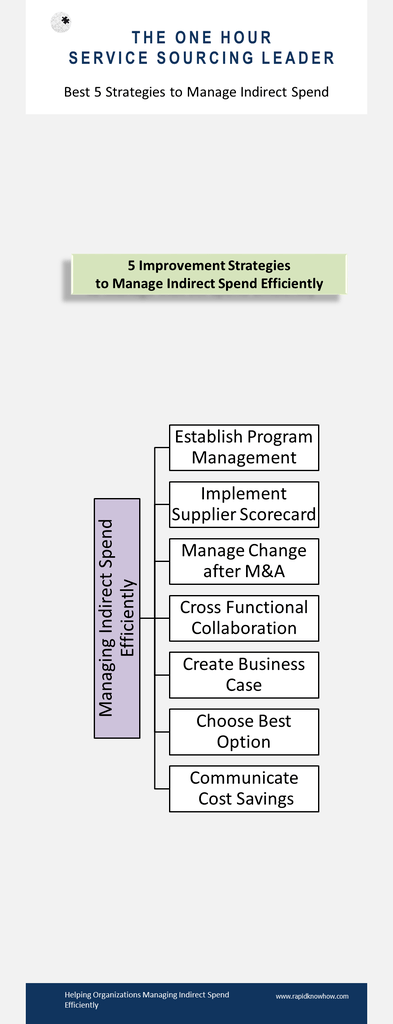In working in various larger organizations there has often been the urgency on how to structure the indirect spend department especially as there are always major changes happening in terms of technological, political & social perspective. Managing the indirect spend can often be an obstacle in many organization as there is an overwhelming entry of new suppliers, no clear know-how on how the supplier market looks like and new products & services are developed in fast manner by corporations to meet the demands of the customers. As matrix organizations and an increase of working in teams on a global level can also cause a confusion and aim to have short-term political gains, which leads to the following question:
 What are the key improvement points in managing the indirect spend?
What are the key improvement points in managing the indirect spend?
1) Provision of Program-Management: Have a clear plan set up in projects with a steering group, taskforce etc. in order to manage your indirect spend. This will decrease the confusion within the organization, why lead buyers ask for more information in relation to the past, from their internal customers. The information can vary from evaluating the supplier performance or planning the purchasing demands for the upcoming years, which again should be part of the program-management and should always have key members from the internal customers in the various taskforces.
2) Implement the Avoid, Develop & Invest Principle: Find approaches where you can avoid various purchasing practices, for example reducing the spend by cutting the purchasing requisition with a joined enhanced planning with the internal customers. A purchase order which runs through the procure-to-pay process costs an organization around € 100,00 (per purchase order). Reducing the purchases from 30,000 to 10,000 could provide a cost saving of € 2,000,000. The idea of Develop would be to implement a supplier-balanced scorecard to regularly evaluate the performance of the vendors and communicate improvement points for the future. Invest stands for investing into e-procurement platforms which could to fasten the vendor selection process, for example e-auctions or e-tendering.
3) Managing change: As change within organization could be caused by mergers for example and could impact the culture, structure and strategic aims of the various departments. Therefore, the sourcing & procurement department is also often affected by meeting budgets from the internal customers within a skeptic business environment. Moreover, leadership is necessary with a plan so the internal stakeholders are not bringing the negative aspects of change “to the outside” or towards the vendors, instead having a cross-functional communication plan on how to manage change which enforces to work closely to the HR department.
4) Cross-functional Collaboration: The purchasing department should aim to work closely towards other departments so the strategic function within the procurement structure should support this matter. Lead buyers should pro-actively seek for what the internal customers want, for example product managers want to sell solutions for their clients which bring to highest margin. Therefore, the lead buyers should always have the principle of Return on Capital Employed by the material groups which have been spend and not the not only price, quality, delivery & payment terms. Therefore, the more you understand your internal customer demands the more you will be able to manage your material group.
5) Document Cost Savings and communicate the executed Business Cases: Documenting savings in a share-point for example supports the procurement department to have a joined saving documentation. The savings should also be provided to other internal stakeholders within the organization, so the internal customers also could use the information for the budget planning for future planned purchases and it also gives the customer an enhanced understanding of the product value.
Want to learn more about how to improve your spend?
As the weekly newsletter “managing your spend” should be a practical support to improve your aims which you have in the area of sourcing & procurement you can simply subscribe to our newsletter. We wish you all the best in managing your indirect spend in your organization and for more questions you can also contact us directly over linkedin under the following link: www.rapidknowhow.com , who is a leading provider in management consulting in digital solutions for CEO or high potentials.
Philip
 Philip David MBA, specializes in crafting your breakthrough service sourcing strategy, evaluating and choosing your strategic service providers, developing your business case for optimizing your total service cost of ownership and leading your implementation project for delivering sustainable results rapidly.
Philip David MBA, specializes in crafting your breakthrough service sourcing strategy, evaluating and choosing your strategic service providers, developing your business case for optimizing your total service cost of ownership and leading your implementation project for delivering sustainable results rapidly.
Contact Philip
Please, use the form below and I will come back within 24 hours.
[CONTACT_FORM_TO_EMAIL id=”4″]

